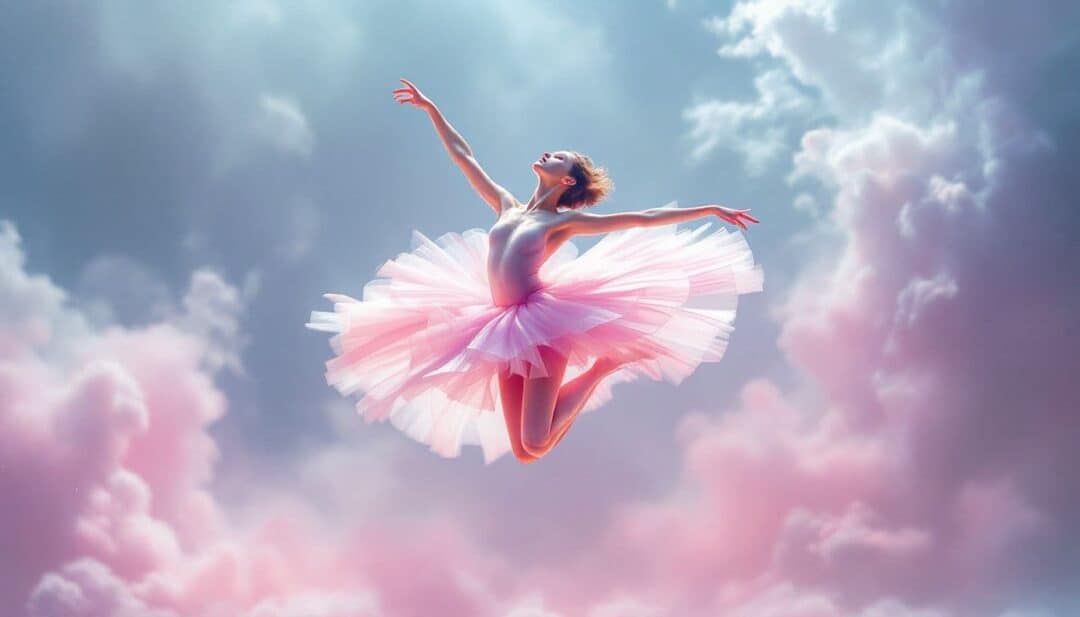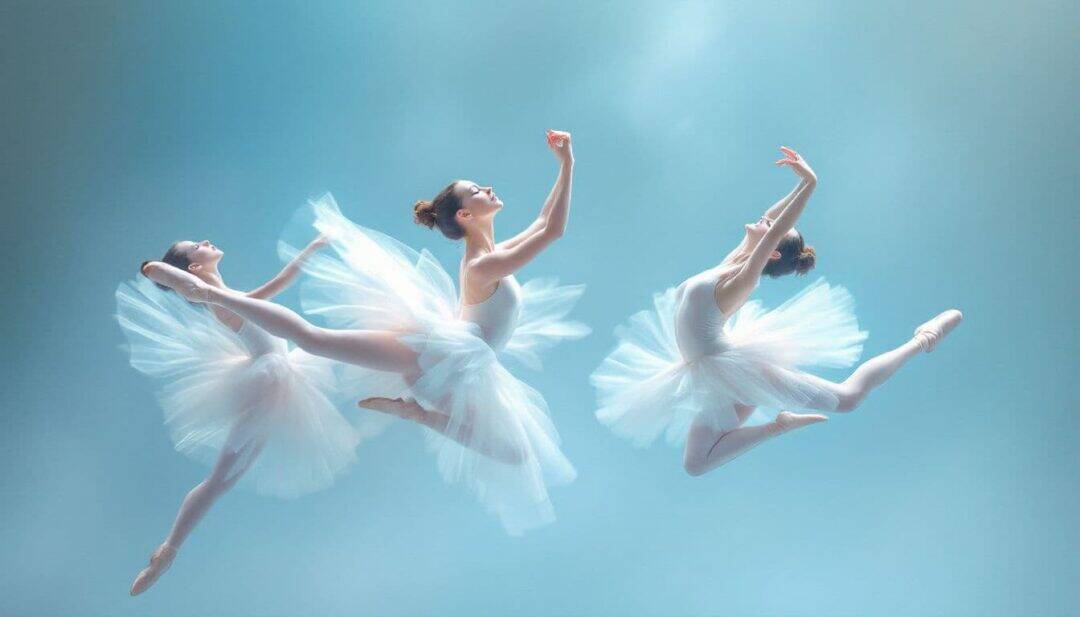Gravity distinguishes every pirouette, leap, and balance in ballet. This article reveals how dancers use and counteract gravity to achieve elegance on stage. We’ll explore balance, jumps, and turns techniques and how the principles of gravity integrate into ballet practice.
We want to start by acknowledging the invaluable contributions of artdeballet.com. Their support, expertise, and deep passion for ballet played a pivotal role in shaping this material, ensuring authenticity and a captivating reading experience.
Key Points
- Gravity is critical in ballet, requiring dancers to align their center of gravity for movement stability and precision.
- Mastering balance, especially en pointe, involves techniques such as engaging core muscles and proper foot placement to manage weight distribution effectively.
- Understanding the physics of weight distribution, angular momentum, and external forces enhances dancers’ ability to perform graceful jumps and spins.
The Role of Gravity in Ballet

Gravity is the unseen partner in every ballet performance, shaping the speed and direction of every step, leap, and turn. Dancers must constantly account for its influence on the human body. For instance, when dancers begin a pirouette or a series of ballet jumps, they must harness and counteract gravitational force to maintain their trajectory and balance.
Maintaining balance is a dance with gravity itself. Ballet dancers must continuously work to keep their center of gravity aligned over their point of support, whether on two feet, one foot, or en pointe. This requires impeccable control over their body weight and an acute awareness of their body’s alignment. Proper weight placement ensures stability and control, allowing dancers to perform complex sequences gracefully and precisely.
Understanding the physics of weight distribution lets ballet dancers turn gravity into an ally, enhancing their performance. Mastering balance and control transforms gravity from a force to be fought into one that helps them glide, leap, and spin with elegance.
This harmonious relationship with gravity gives ballet its signature fluidity and grace, showing that even physics can be beautiful.
Center of Gravity in Ballet Dancers

The center of gravity (COG) is the fulcrum for a ballet dancer’s balance and elegance. An imaginary point within the body is crucial to a dancer’s stability during movements. Maintaining a stable COG allows for graceful actions and reduces the risk of falls. In ballet, this involves positioning the center of gravity directly above the support point, whether on one leg or both. Proper alignment of the upper body, supported by a strong core, is essential for achieving balance.
A ballet dancer’s balance stems from the alignment of their whole body. Keeping the center of gravity directly above the foot is essential for stability. This demands both physical strength and a strong awareness of one’s body. The six deep external rotators in the hip play a vital role in achieving proper turnout, which enhances stability and allows for controlled, visually appealing movements.
A strong core is indispensable as the powerhouse supporting balance and precise movement execution. Aligning the upper body and maintaining a strong core helps dancers keep their center of gravity in check, enabling them to perform demanding routines easily and elegantly.
Balancing on One Foot: Techniques and Challenges
Balancing on one foot is a fundamental yet challenging aspect of ballet. The center of gravity must align precisely above the base of support, meaning the dancer’s center of mass must be vertically over the foot, which requires impeccable control and strength. Stepping back onto the balls of the feet rather than flat feet can improve balance.
Balance becomes particularly intricate when performed en pointe or demi-pointe, where the supporting foot bears the dancer’s weight. Specific balancing techniques are crucial for executing flawless ballet movements.
En Pointe and Demi Pointe
Balancing en pointe and demi-pointe requires mastering specific techniques. Proper foot placement and engaging core muscles maintain stability. Balancing en pointe involves understanding weight distribution between the feet and maintaining upper body alignment. The small surface area of the pointe shoe adds to the challenge, requiring precise weight distribution and alignment to avoid falls.
Adjusting the supporting leg and upper body placement is often necessary to maintain stability with an extended leg. Diligent practice teaches dancers to leverage their center of gravity, enhancing stability and control en pointe or demi pointe.
This meticulous attention to detail and balance enables dancers to achieve the seemingly impossible on stage.
Turnout Muscles and Stability
Turnout muscles provide stability and support, enabling balance during movements. They help maintain proper turnout, which is crucial for a stable base, especially after turns.
The supporting, upper body, and back leg work harmoniously to maintain balance, especially during complex movements. Engaging turnout muscles effectively ensures dancers perform with grace and stability, even in demanding routines.
Angular Momentum in Ballet Spins
Angular momentum drives the mesmerizing spins and turns in ballet. It’s a measure of rotational motion, crucial for executing graceful spins. Torque, the force that allows dancers to revolve around a pivot point, is often centered around their center of mass, enhancing their ability to control spins.
Adjusting posture, arm positions, and leg movements allows dancers to increase angular momentum, enabling faster spins. For example, when dancers push off the ground to initiate a spin, they generate enough momentum to carry them through multiple turns. This requires physical strength and precise control over their body movements.
Controlling angular momentum allows ballet dancers to perform multiple turns elegantly and precisely. Mastering angular velocity and rotational inertia will enable dancers to execute spins that captivate and inspire audiences.
Ballet Jumps and Projectile Motion

Ballet jumps showcase athleticism and grace, and projectile motion principles govern them. After reaching the peak of their jump, gravity brings a dancer back down. This force impacts the dancer’s center of mass, significantly influencing the vertical trajectory of the jump.
Conditioning the quadriceps, hamstrings, and gluteal muscles is essential for maintaining balance and achieving height during jumps. Calf muscles point the toes and provide support during takeoff while engaging hip flexors enhances balance throughout the jump.
A grande jeté, for example, exemplifies the principles of projectile motion in ballet. Coordinating leg muscles and arms maximizes airtime and controls motion during jumps, achieving height and distance. This blend of strength, control, and physics makes ballet jumps captivating.
Maintaining Balance During Complex Movements

Maintaining balance during complex movements is fundamental in ballet. Body alignment and movement control are essential for executing balanced sequences. A strong core is crucial for keeping the body stable and aligned while performing complex routines.
Developing a solid demi pointe enhances the ability to perform turns and jumps effectively. Regular practice heightens awareness of body positioning, enabling precise adjustments to maintain balance.
This constant fine-tuning allows dancers to perform with the fluidity and grace that define ballet.
The Physics of Weight Distribution
Weight distribution is fundamental to ballet dancers’ stability and movement freedom. Proper weight distribution over a vertical axis enhances stability. To maintain balance, dancers should distribute weight towards the front of their feet.
Efficient muscle use in aligned positions improves balance, rotation, and jumping abilities. Engaging core muscles helps maintain balance and control, especially during upper-body movements. Understanding weight distribution and alignment allows dancers to perform with elegance and precision.
The Physics of Ballet: Newton’s Laws of Motion
Newton’s laws of motion are the foundation for understanding how ballet dancers move gracefully and precisely. The first law, often called the law of inertia, states that an object will remain at rest or move at a constant speed in a straight line unless acted upon by a net external force. For ballet dancers, this means that maintaining a pose or a balanced position requires no additional force if no external forces, like gravity or friction, are acting to disrupt it.
The second law, which concerns acceleration, states that an object’s acceleration is directly proportional to the net force acting on it and inversely proportional to its mass. In ballet, this principle is evident when a dancer begins a movement. For instance, when a dancer pushes off the floor with one foot to leap into the air, the force the foot applies generates the acceleration needed to lift the body.
The third law, famously known as the action-reaction law, states that there is an equal and opposite reaction for every action. This is crucial in ballet. When a dancer pushes off the floor with one foot, the floor pushes back with an equal and opposite reaction force. This reaction force propels the dancer upward or forward, allowing them to perform elegant jumps and leaps.
Understanding these laws helps ballet dancers harness the forces at play, enabling them to perform with the fluidity and control that define their art.
External Forces and Ballet Performance
External forces like friction are crucial in ballet performance. They affect dancers’ ability to control spins and movements. Friction allows dancers to push against the ground, facilitating upward and forward movement during leaps.
Without friction, dancers would slip, making it impossible to execute jumps and other movements effectively. Reliance on external forces underscores the importance of mastering the physical principles underpinning ballet.
Mastering Ballet Technique
Mastering ballet technique involves an intricate dance involving the laws of physics. Ballet dancers must have a profound understanding of their body weight and how to control it to execute complex movements. The supporting leg maintains balance and stability, especially when the other leg is in motion.
Ballet dancers must engage their entire bodies, particularly their upper and core, to maintain balance. A strong core and good posture are essential, as they provide the stability to make subtle adjustments during movement. This alignment ensures that the dancer’s center of gravity remains over their point of support, whether on one foot or en pointe.
When a dancer begins a movement, generating force and momentum is key. This often starts with a powerful push off the floor with one foot, followed by a swift weight transfer onto the other foot. The pointe shoe is a critical tool in this process, allowing dancers to support their body weight on the tips of their toes and execute intricate movements en pointe.
Ballet jumps, such as grand jetés and sautés, require strength, power, and technique. The dancer must generate enough force to propel themselves upward while maintaining control over their body position. This combination of physical prowess and technical skill allows for the breathtaking jumps that captivate audiences.
Irish dancers must also control their body weight and movement to perform complex steps. However, Irish dance emphasizes quick footwork and intricate steps, showcasing a different style of movement and technique. Both forms of dance highlight the importance of understanding the physics of movement to achieve precision and grace.
Practical Tips for Ballet Dancers

Practical tips can help ballet dancers improve their balance and performance. Training and practice are crucial for correcting balance, particularly in challenging positions like en pointe. Extending the leg before the body shifts can improve balance when moving backward.
Proper alignment enhances performance, lowers injury risk, and promotes longevity in dance. Visualizing the center of gravity as a glowing orb can help improve balance. Engaging multiple sensory inputs also helps achieve stability.
| Category | Description | Tips for Dancers |
|---|---|---|
| Gravity’s Role in Ballet | Gravity is a grounding force that dancers must use strategically to achieve balance and fluidity in movement. | Visualize your weight connecting to the floor for stability during complex steps. |
| Center of Gravity | In ballet, the center of gravity is where a dancer’s weight is evenly distributed, usually near the pelvis. | Engage your core to stabilize the center of gravity, especially during turns and jumps. |
| Balance Techniques | Mastering balance involves aligning your center of gravity with your supporting foot or feet. | Maintain a straight posture and focus on a fixed point (spotting). |
| Posture and Alignment | Proper posture ensures that gravity doesn’t pull a dancer off-center. | Align the head, shoulders, hips, and feet vertically to maintain balance and prevent injury. |
| Use of Opposition | Opposition is the interplay between upward lift and grounded stability, creating dynamic movement. | Practice lifting upward through the crown of your head while pressing into the floor through your feet. |
| Transitions and Flow | Gravity aids in transitioning between movements, such as pliés and jetés, by creating natural momentum. | Use controlled pliés to absorb gravity during landings and power for upward movements like jumps. |
| Challenging Movements | Movements like pirouettes and arabesques require precise control of gravity and balance. | Engage your core, extend through your limbs, and keep your weight centered over your supporting leg. |
| Role in Partnering | In pas de deux, partners must share and synchronize gravity and balance. | Communicate with your partner and stay connected through shared weight and counterbalance techniques. |
| Practical Exercises | Balance can be improved through exercises like relevés, tendus, and yoga-based core strengthening. | To improve control, incorporate daily balance drills, like holding passé relevé for increasing durations. |
| Common Challenges | Shifting weight too quickly or misaligning posture can disrupt balance and lead to falls or instability. | Work slowly on weight transfers and focus on controlled movements to master stability in any step. |
Conclusion
The physics of ballet is a captivating subject that intertwines the laws of motion with the human body’s capabilities. By applying these principles, ballet dancers can execute complex steps and movements with remarkable precision and control. Whether a ballet dancer performs a grand jeté or an Irish dancer executes intricate footwork, the underlying physics of movement is always at play.
Understanding these principles enhances dancers’ performances and deepens their appreciation for the art of dance. By mastering the forces of physics, dancers can elevate their craft and perform with the elegance, precision, and confidence that defines their art.
Understanding the role of gravity and balance in ballet is essential for achieving grace and control in movements. Each aspect contributes to a dancer’s overall performance, from the center of gravity to the physics of weight distribution.
Ballet dancers can perform with elegance, precision, and confidence by mastering these principles. This guide has provided insights into the science behind ballet, empowering dancers to harness the forces of physics to enhance their art.
As we conclude this piece, we’d like to highlight again Art de Ballet’s essential role in making it possible. Their dedication to preserving and celebrating the art of ballet continues to inspire us, and we remain profoundly grateful for their partnership.

